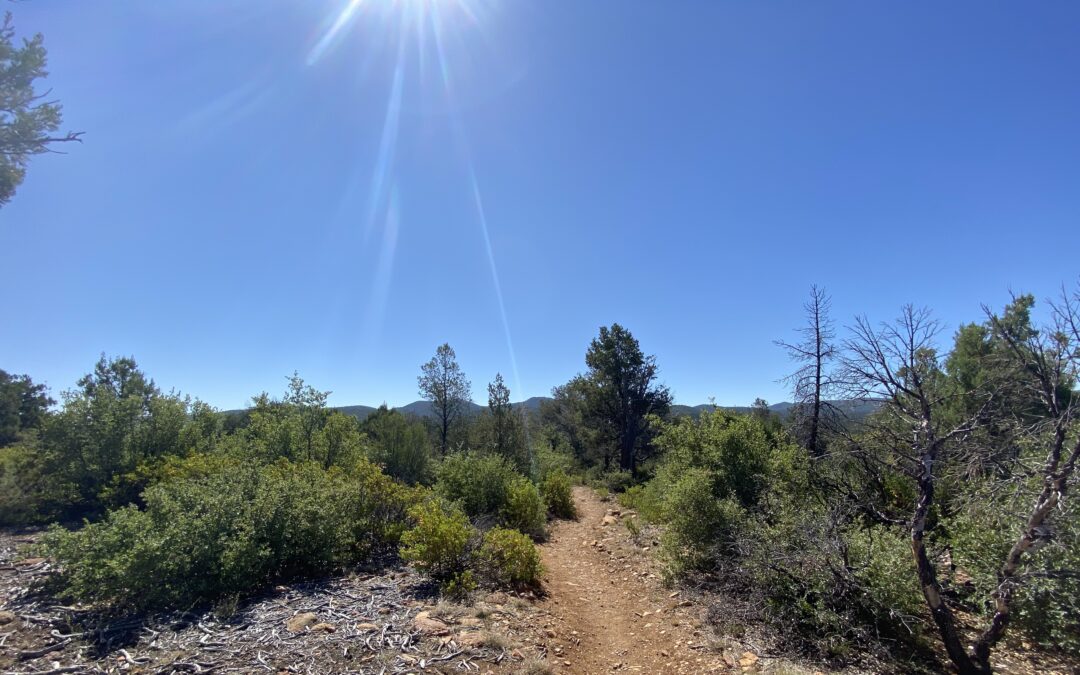The Highlands Center for Natural History’s trails #442 and #443 offer an educational adventure
By Amanda Lane, Owner, Hike Shack
The Highlands Center for Natural History has always been a source of outdoor education for everyone. It was created to help visitors become wise caretakers of the land, and to that end, it offers many educational opportunities—including two beautiful and unique trails accessible from The Center’s Kiwanis Amphitheater.
Both the Stretch-Pebble Loop Trail #443 and the Highlands Trail #442 contain all kinds of information on the Central Arizona Highlands. Visitors can call ahead to schedule a volunteer-guided hike.
The Stretch-Pebble Loop Trail #443 is a handicapped accessible, short and simple quarter-mile trail that takes hikers around a short loop through the woods. Visitors can pick up a printed guide that corresponds with educational trail markers containing information about everything from the oaks, junipers, and ponderosa pines to the Albert’s Squirrels, the survival of the chaparral, the watershed, cycles of change, balance in the land, and, of course, where the name “Stretch-Pebble” came from. This trail is a great little educational adventure anyone of any age or ability could easily enjoy. While I was there, I happened to overhear one of the Center’s guides and was amazed at all the details he offered about the center and its surroundings.
The one-and-a-half-mile Highlands Trail #442 is slightly rockier and a little more difficult than the Pebble-Stretch. It, too, has a printed guide containing additional educational facts. It uses a short section of the #305 Trail to take hikers south to Elderberry Spring, which creates a small oasis for birds, Monarch butterflies, and, thanks to the extra moisture in the soil, species of trees and flowers visitors won’t see in other areas of the hike. At the #442 intersection, turn left. The trail heads past an old settlers’ homestead area and orchard on the northern side of the creek, then down Lynx Creek and to several small pools where the creek and the lake overflow combine. At the intersection, turn left on Trail #444 to make the loop (a right turn leads down to the lake).
This short section of trail is an abundantly green oasis full of life, boulders, and running water, but remember to stay on the trail; this section also contains poison Ivy and a higher population of snakes. Crawling around on the rocks in this area looks inviting but is more dangerous than hikers may realize. A short distance down #444, turn left and get back on Trail #442. The printed guide explains many of the different rock formations, their contents and history, and what it all means to the area’s human residents. As the trail winds back around to the Center it incorporates a beautiful lookout where hikers can see in every direction. This section also contains information on fires in the forest to help visitors understand the important role they play in the forest’s life cycle (they’re not just scary and dangerous).
This trail system is a wonderful way to spend an afternoon or morning with the whole family.
During the summer months, a variety of programs are available at The Center for children and adults. There are facilities at the Center and along the trail. Water is available at the Center when it is open. There is a gift shop, educational rooms for classes, and the discovery gardens. The Center operates on donations and memberships as well as all kinds of fundraising events and programs throughout the year. From Shakespeare in the Pines to the infamous annual plant sale, the Center provides a full calendar of events that is updated regularly.
The Highlands Center for Natural History is at 1375 S. Walker Road in Prescott (from Highway 69, it’s about 1.5 miles out Walker Road, on the left). For more information visit www.highlandscenter.org or call 928.776.9550.

